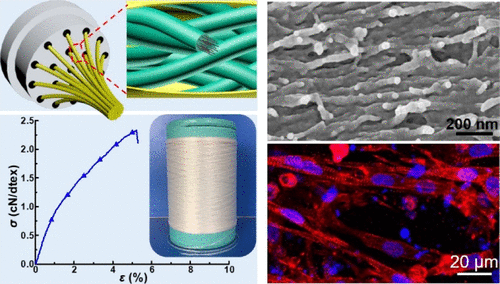当前位置:
X-MOL 学术
›
Chem. Mater.
›
论文详情
Our official English website, www.x-mol.net, welcomes your feedback! (Note: you will need to create a separate account there.)
Mechanically Strong Chitin Fibers with Nanofibril Structure, Biocompatibility, and Biodegradability
Chemistry of Materials ( IF 7.2 ) Pub Date : 2019-02-25 00:00:00 , DOI: 10.1021/acs.chemmater.8b05183 Kunkun Zhu 1 , Hu Tu 1 , Pengcheng Yang 2 , Cuibo Qiu 3 , Donghui Zhang 2 , Ang Lu 1 , Longbo Luo 3 , Feng Chen 3 , Xiangyang Liu 3 , Lingyun Chen 4 , Qiang Fu 3 , Lina Zhang 1
Chemistry of Materials ( IF 7.2 ) Pub Date : 2019-02-25 00:00:00 , DOI: 10.1021/acs.chemmater.8b05183 Kunkun Zhu 1 , Hu Tu 1 , Pengcheng Yang 2 , Cuibo Qiu 3 , Donghui Zhang 2 , Ang Lu 1 , Longbo Luo 3 , Feng Chen 3 , Xiangyang Liu 3 , Lingyun Chen 4 , Qiang Fu 3 , Lina Zhang 1
Affiliation

|
The environment-friendly fibers fabricated from natural polysaccharides have attracted much attention in the development of sustainable materials, owing to the global pollution caused by fibers and textiles fabricated from petroleum-based polymers. Chitin derived from seafood wastes possesses excellent biocompatibility and biodegradability, but it is still far from being fully explored. Here, we designed and prepared, for the first time, chitin fibers with nanofibril structures from the chitin solution in the NaOH/urea aqueous system by cooling on a lab-scale wet-spinning machine. Because of the slow diffusion of phytic acid into the chitin dope, the stiff chitin chains could self-aggregate sufficiently in a parallel manner to form the nanofibers via a “bottom-up” approach and then be bundled into the gel-state fibers. The dried chitin fibers were demonstrated to be composed of nanofibers with a mean diameter of 27 nm and exhibited a tensile strength of 2.33 cN/dtex, which is higher than those reported in the literature. Interestingly, with an increase of the draw ratio from 1.0 to 1.8, the crystal index (χc) and degree of orientation (Π) increased very slightly, whereas the tensile strength and Young’s modulus of the chitin fibers enhanced significantly, suggesting that a relatively perfect nanofibrous structure existed in all of the chitin fibers with and without drawing. Moreover, the chitin fibers were validated to support the adhesion and growth of ventricular myocytes as a cardiac tissue scaffold showing good biocompatibility. Furthermore, the complete biodegradation time of the chitin fibers in soil and in vitro could be extrapolated from experimental data to be approximately 22 and 34 days, respectively, indicating good biodegradability. This work would lead to a great potential of chitin in the applications including absorbable surgical suture, hemostasis and fixation medical device, and so forth, where biodegradability is required.
中文翻译:

具有纳米原纤结构,生物相容性和生物降解性的机械强度几丁质纤维
由于由石油基聚合物制成的纤维和纺织品造成的全球污染,由天然多糖制成的环保纤维在可持续材料的开发中备受关注。来自海鲜废物的几丁质具有极好的生物相容性和生物降解性,但距离充分开发尚远。在这里,我们首次通过在实验室规模的湿纺机上冷却,从NaOH /尿素水体系中的几丁质溶液中设计并制备了具有纳米原纤结构的几丁质纤维。由于植酸缓慢扩散到几丁质涂料中,坚硬的几丁质链可以通过“自下而上”的方法以平行的方式充分自聚集,形成纳米纤维,然后被捆绑成凝胶态纤维。已证明干燥的几丁质纤维由平均直径为27 nm的纳米纤维组成,并具有2.33 cN / dtex的拉伸强度,高于文献报道的那些。有趣的是,随着拉伸比从1.0增加到1.8,晶体指数(χC)和取向度(Π)非常轻微地增加,而几丁质纤维的抗张强度和杨氏模量显着提高,表明在有和没有拉伸的情况下,所有几丁质纤维均存在相对完善的纳米纤维结构。此外,作为心脏组织支架表现出良好的生物相容性,几丁质纤维经验证可支持心室肌细胞的粘附和生长。此外,可以从实验数据推断出几丁质纤维在土壤中和在体外的完全生物降解时间分别为约22天和34天,表明良好的生物降解性。这项工作将导致甲壳素在需要可生物降解性的应用(包括可吸收的外科缝合线,止血和固定医疗器械等)中具有巨大的潜力。
更新日期:2019-02-25
中文翻译:

具有纳米原纤结构,生物相容性和生物降解性的机械强度几丁质纤维
由于由石油基聚合物制成的纤维和纺织品造成的全球污染,由天然多糖制成的环保纤维在可持续材料的开发中备受关注。来自海鲜废物的几丁质具有极好的生物相容性和生物降解性,但距离充分开发尚远。在这里,我们首次通过在实验室规模的湿纺机上冷却,从NaOH /尿素水体系中的几丁质溶液中设计并制备了具有纳米原纤结构的几丁质纤维。由于植酸缓慢扩散到几丁质涂料中,坚硬的几丁质链可以通过“自下而上”的方法以平行的方式充分自聚集,形成纳米纤维,然后被捆绑成凝胶态纤维。已证明干燥的几丁质纤维由平均直径为27 nm的纳米纤维组成,并具有2.33 cN / dtex的拉伸强度,高于文献报道的那些。有趣的是,随着拉伸比从1.0增加到1.8,晶体指数(χC)和取向度(Π)非常轻微地增加,而几丁质纤维的抗张强度和杨氏模量显着提高,表明在有和没有拉伸的情况下,所有几丁质纤维均存在相对完善的纳米纤维结构。此外,作为心脏组织支架表现出良好的生物相容性,几丁质纤维经验证可支持心室肌细胞的粘附和生长。此外,可以从实验数据推断出几丁质纤维在土壤中和在体外的完全生物降解时间分别为约22天和34天,表明良好的生物降解性。这项工作将导致甲壳素在需要可生物降解性的应用(包括可吸收的外科缝合线,止血和固定医疗器械等)中具有巨大的潜力。











































 京公网安备 11010802027423号
京公网安备 11010802027423号